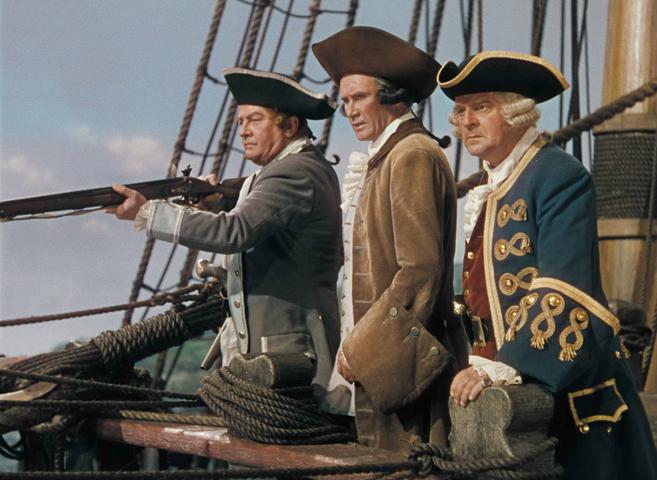Yarrrrrrrrrr! Movie pirates didn’t have heavy West Country accents before Robert Newton’s famous turn as Long John Silver in the 1950 version of Treasure Island. Disney’s first-ever live action film is aimed squarely at school age boys, but is also pleasant for grown-ups to revisit on a rainy Sunday afternoon. The film’s production values hold up well even 60 odd years on, and, while even older, R. L. Stevenson’s 1883 story (with some amendments) retains its charm and excitement even for modern audiences.
The story opens with young Jim Hawkins tending the bar in his mother’s inn (She herself nor any other significant female character appears in the film, so we are truly in boyland here). In comes Black Dog, a menacing Pirate in search of Captain Billy Bones, who is hiding out at the inn. After Black Dog leaves, Billy Bones gives young Jim a treasure map and tells him to flee before the pirates return. Jim confides in two honorable adults, Squire Trelawny and Dr. Livesy. Our heroes set sail in search of pirate treasure, not realizing that the old sea dog they have hired as the cook is the dread Long John Silver, and most of the crew are his own bloodthirsty band of brigands! Thems that die’ll be the lucky ones, arrrrhh!!! Adventure, thrills and some welcome moments of humor and humanity ensue.

The emotional heart of the film are Long John Silver (Robert Newton) and Jim Hawkins (Bobby Driscoll). The good adults led by Squire Trelawny are uniformly noble and brave, the pirates (other than Long John) are uniformly nasty and craven. With that as a flat background, Silver and Hawkins really come to life. Long John is the only adult of complex character in the story, being in some ways cunning and greedy but in other respects moral and kind. And because Jim is the only character who travels between the worlds of the oh-so-good-heroes and the oh-so-evil pirates, he becomes a finely shaded character too, particularly as he learns to appreciate that his sometimes-friend Silver is neither a thoroughgoing villain nor a worthy role model.
Newton’s flavourful acting makes this film hum and is worthy of admiration. A less professional actor would have condescended to only a half-hearted or one-dimensional performance, seeing a “children’s film” as beneath him. But Newton goes all in, bless his cotton socks. He will likely always be cinema’s iconic Long John Silver and Silver will certainly always be his most famous role even though he turned in many strong performances in his career (e.g., as Bill Sykes in David Lean’s fine adaptation of Oliver Twist). Newton never makes Silver so evil that the audience can just hate him outright (as hammier actors have in other adaptations of Stevenson’s novel), but neither does he minimize the cruel aspects of the character that make him scary and thereby provide much of the tension of the story.
Bobby Driscoll, who already had an Academy Award to his credit, is compelling in the dramatic scenes and also in the action scenes. He gives us a Jim Hawkins who is emotionally vulnerable yet also has a lot of front, particularly during his hair-raising encounter with two pirates when he returns alone to the Squire’s ship. Driscoll’s appealing, nuanced performance helps make Treasure Island not just an fine adventure story for children but also a knowing reflection upon the joys and mysteries of growing up and entering the society of adults.
p.s. Two bits of a trivia about the film. Disney initially broke away from only doing animated features because money earned in England could not be repatriated after the war. In the late 1940s, Disney Studios had box office earnings frozen in the UK, a studio full of animators in Burbank, and a nearly empty bank account. Ever the shrewd businessman, Walt adapted by making live-action movies abroad. Finally, on a sad note, Newton and Driscoll both died very young from addictions (alcohol in Newton’s case, narcotics in Driscoll’s). The toll addictions take is serious everywhere, but in the film industry, it seems particularly pronounced.

